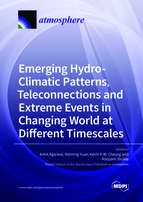Emerging Hydro-Climatic Patterns, Teleconnections and Extreme Events in Changing World at Different Timescales
A special issue of Atmosphere (ISSN 2073-4433). This special issue belongs to the section "Climatology".
Deadline for manuscript submissions: closed (31 December 2021) | Viewed by 38015
Special Issue Editors
2. Visiting Scientist at Helmholtz Centre Potsdam GFZ German Research Centre for Geosciences, section 4.4 Hydrology, 14473 Potsdam, Germany
Interests: data-driven analysis of complex systems; unraveling multiscale dynamics of the Earth system; hydroclimatology; hydroclimatic patterns; teleconnections; extreme events; soft computing skills; big data; wavelets and complex network
Interests: climate prediction; predictability; climate network; extreme events; nonlinear processes in geoscience; multiscale interactions in climate system; stochastic processes
Interests: tropical meteorology; severe weather; climate dynamics; nonlinear science; numerical analysis and prediction
Special Issues, Collections and Topics in MDPI journals
Interests: climate vulnerability; adaptation planning; extreme events; climate change and climate resilience
Special Issue Information
Dear Colleagues,
Unraveling spatiotemporal patterns and interactions among climate variables, especially those related to hydroclimate, has always been an important task for geoscientists in general, and for climatologists in particular, mostly because it contributes significantly to better prediction and forecasting. However, complexities are intrinsic to natural systems, and for this reason, the task of identifying patterns and interactions has always been challenging. Coupled with the existing challenges of global-warming-induced climate change, these patterns and interactions become further unusual, unexpected, and unpredictable. With these challenging realities, climate science studies globally recognize that climatic and other geophysical processes are intrinsically nonlinear and carry multiscale features along with influences that are in general of time-varying nature. This Special Issue is largely prompted by these realizations and an implied aspiration to develop a collection of advanced studies addressing aforementioned issues.
This Special Issue is expected to advance our understanding of these emerging patterns, teleconnections, and extreme events in a changing world for more accurate prediction or projection of their changes especially on different spatial–time scales. We invite authors to submit original and review articles that aim to study new patterns, interaction and its variability, including its impact to climate extremes, such as drought, flooding, heat waves, and so on. Submissions of recent progress in observational, modeling, and theoretical studies in relation to new connections interactions, especially those that apply advanced techniques to analyze the nonlinearity and multiscale nature of processes, are welcome.
Dr. Ankit Agarwal
Dr. Naiming Yuan
Dr. Kevin Cheung
Dr. Roopam Shukla
Guest Editors
Manuscript Submission Information
Manuscripts should be submitted online at www.mdpi.com by registering and logging in to this website. Once you are registered, click here to go to the submission form. Manuscripts can be submitted until the deadline. All submissions that pass pre-check are peer-reviewed. Accepted papers will be published continuously in the journal (as soon as accepted) and will be listed together on the special issue website. Research articles, review articles as well as short communications are invited. For planned papers, a title and short abstract (about 100 words) can be sent to the Editorial Office for announcement on this website.
Submitted manuscripts should not have been published previously, nor be under consideration for publication elsewhere (except conference proceedings papers). All manuscripts are thoroughly refereed through a single-blind peer-review process. A guide for authors and other relevant information for submission of manuscripts is available on the Instructions for Authors page. Atmosphere is an international peer-reviewed open access monthly journal published by MDPI.
Please visit the Instructions for Authors page before submitting a manuscript. The Article Processing Charge (APC) for publication in this open access journal is 2400 CHF (Swiss Francs). Submitted papers should be well formatted and use good English. Authors may use MDPI's English editing service prior to publication or during author revisions.
Keywords
- Spatiotemporal patterns
- Teleconnections
- Climatic variables
- Climate change and variability
- Climate dynamics
- Extreme climate/weather
- Large-scale interactions
- Nonlinear and multiscale approach









